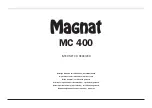
DIRECTV PARA TODOS™ SYSTEM FROM HUGHES - OWNER’S MANUAL
P
AGE
2-2
•
The capabilities of your TV and VCR.
•
Your desire to pass local programming through the digital satellite receiver.
•
Any other devices you want to include in the system (stereo, second VCR, etc.).
Before attempting to connect anything, position yourself so you are looking at the back of your
components. Note the various input and output receptacles, their shapes, and how they are labeled.
Then read through the rest of this hookup section before going ahead with actual hookup.
Do not turn on the power yet. For your safety, make sure the digital satellite receiver, TV, VCR, and
any other devices to be connected are unplugged from the wall outlet while hooking them up.
Hook Up the Audio/S-video Signals
Only the newest, high-end TVs and VCRs have S-video inputs. VCRs that support S-video include Hi8
and SVHS types. Look on the back of your TV and VCR for this special jack. It will
probably be labeled
S-VIDEO IN
. If you are unsure, you can see the type of connector
that you are looking for on the back of the digital satellite receiver. If neither the TV
nor VCR has this jack, proceed to the “Hook Up the Audio/Video Signals” section.
This hookup will give you the sharpest picture of any of the hookups. Also, this hookup will allow you
to view DIRECTV PARA TODOS™ programming and local broadcast simultaneously on TVs with
“picture in picture” (PIP) feature.
When using this hookup, you cannot use the digital satellite receiver as a switch to choose between
DIRECTV PARA TODOS™ System programming and local broadcasts. Instead, you will use the
input selection that your TV and/or VCR offers to select the source.
If your VCR has S-video input…
use an S-video cable to connect the digital satellite receiver’s
S-VIDEO
output to the S-video input on
your VCR. Also connect one pair of the digital satellite receiver’s audio outputs (Left and Right) to the
audio inputs on your VCR.
If your TV has S-video input…
connect an S-video cable from the
S-VIDEO
output (either from the digital satellite receiver if
available or the VCR) to the S-video input on the TV. Also connect the left and right audio outputs
from the same device that the S-video is coming from and connect them to the TV.
If you have a stereo system…
you may be able to achieve big speaker sound. See the “Hook Up to a Stereo System” section for the
necessary connections.
If your hookup is complete…
move on to the “Finishing Up” section.
Hook Up the Audio/Video Signals
Most high-end TVs and VCRs have phono-type audio and video inputs. Look at the back of your TV
and VCR for three jacks—possibly color coded yellow, white and red. They will
be labeled something like
IN
(
L
and
R
),
AUDIO IN
, and
VIDEO IN
. If you are
unsure, look at these connectors on the back of the digital satellite receiver. If
you have no jacks like these on your TV or VCR, skip this section and proceed to
the “Hook Up the RF Signals” section.
This video hookup will give you a clearer picture than an RF hookup. Also, this hookup will allow you
to view DIRECTV PARA TODOS™ programming and local terrestrial broadcast simultaneously on
TVs that offer a “picture in picture” (PIP) feature.
When using this hookup, you cannot use the digital satellite receiver as a switch to choose between
DIRECTV PARA TODOS™ programming and local terrestrial broadcasts. Instead, you will use the
input selection that your TV and/or VCR offer to select the source.
The S-video cable and jack
The phono-type video cable and jack
Summary of Contents for HIRD-E6
Page 1: ...Model HIRD E61 Digital Satellite Receiver Owner s Manual P N 1028188 0001 REV B ...
Page 26: ......
Page 30: ......
Page 40: ......














































